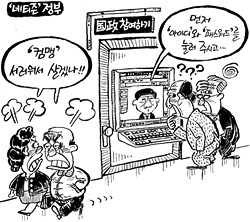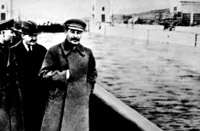Found 4305 matches from 1,400 records in about 0.1668 seconds for phone or e or geodeta.
“Today, in Venezuela, the uniformed Armed Forces build housing and infrastructure. It’s interesting; one of the key demands of the ‘opposition’ is to prohibit the army from building houses! The poor cheer when the military enters their neighborhoods, because they’re usually coming to build some houses. Not, like before, when they came to round up the dissidents and repress the social movements.”
This interview on Indymedia prompted me to do a little googling.
President Chavez’s Plan Bolivar 2000 is part public works administration, part poverty reduction plan, part fight against corruption. Despite Venezuela’s immense oil reserves, 80% of the population lives in poverty. To execute the plan, Chavez brought in military officers to bypass civilian agencies he considered corrupt. The military are working with communities and civilian engineers to build and repair roads, schools, housing, and medical centers around the country.
Critics charge that the plan has just shifted the corruption to the military. Chavez has acknowledged incidents of corruption and has ordered the Auditor-General of the Republic to investigate. Other internal investigations have taken place, though are staffed by military officers investigating other military officers. In response to charges, Chavez announced he will reduce ‘secret’ military spending and that more expenditures will be made public.
I’m having a hard time finding data on the status of the project, but one Captain estimates that Bolivar 2000 has already rebuilt or refurbished some 4,000 schools, clinics and hospitals.
“Indonesia’s pulp and paper industry has rapidly expanded since the late 1980s to become one of the world’s top ten producers. But the industry has accumulated debts of more than U.S.$20 billion, and expanding demand consumes wide swathes of Sumatra’s lowland tropical forests. This land is claimed by indigenous communities, who depend on them for rice farming and rubber tapping. The loss of access to forests, together with companies, hiring from outside the province, has been devastating to local livelihoods, leading to violent conflicts.
Asia Pulp & Paper (APP) is Indonesia’s leading paper producer, and owner of one of the largest stand-alone pulp mills in the world, the Indah Kiat mill in Riau, Sumatra. The mill’s primary fiber supplier, Arara Abadi, established its pulpwood plantation in the 1980s-90s, under then President Soeharto. Arara Abadi, backed by state security forces, routinely seized land for the plantations from indigenous communities without due process and with little or no compensation.
Since the fall of Soeharto in May 1998, local residents have attempted to press their claims, but have met with unresponsive law enforcement. With no remedy for their grievances, communities have increasingly turned to vigilantism. Arara Abadi has responded with violence and arrests.
[In 2001] local villagers in Mandiangin, Betung, and Angkasa/Belam Merah... set up blockades or began logging plantation trees. Hundreds of club-wielding company militia attacked residents, seriously injuring nine and detaining sixty-three. Indonesian police, who trained the civilian militias and also were present during the attacks, were complicit....
The majority of police and military spending (70 percent) comes from off-budget business ventures, many of which are in the forestry sector. These business ties set up an economic conflict of interest in law enforcement. In addition, Arara Abadi’s security personnel have no guidelines for the use of force and are not held accountable for violations of the rights of local people.”
See Without Remedy: Human Rights Abuse and Indonesia’s Pulp and Paper Industry.
Though Human Rights Watch implicates funding by multilateral financial institutions like the World Bank and International Monetary Fund and places the paper industry in the context of foreign dept, they do not address the fact that APP’s assets (valued at US$ 17.5 billion) are largely financed by is shareholders (25%), bondholders (38%) and banks (20%). Many of the biggest investment banks and export credit agencies in the U.S., Europe, and Asia have provided loans and guaranteed this finance over the last ten years. Friends of the Earth names the names and lists UK distributors of APP Paper.
In South Korea, it’s the mouse that roars
New breed of politician taps the country’s love affair with high tech
“The winning candidate in last week’s South Korean presidential election had little need for mass rallies or traditional campaign tactics.
When Roh Moo-hyun’s organizers wanted supporters to vote on election day, they simply pressed a few computer keys. Text messages flashed to the cellphones of almost 800,000 people, urging them to go to the polls.
During his campaign, millions of voters absorbed Mr. Roh’s message from Internet sites that featured video clips of the candidate and audio broadcasts by disc jockeys and rock stars. Half a million visitors logged on to his main Web site every day to donate money or obtain campaign updates. More than 7,000 voters a day sent him e-mails with policy ideas. Internet chat groups buzzed with debate on the election....
Almost half of South Korean voters are below the age of 40 — a prime demographic for users of the Internet and cellphones. Until this year, many were apathetic politically, put off by the country’s traditional political machinery. But Mr. Roh reached out to voters with one of the world’s most sophisticated Internet campaigns, and the vast majority of the younger population voted for him.
Until a year ago, Mr. Roh was best known for his repeated failures to be elected to parliament. Self-educated, he came from a poor family and had been jailed for helping dissidents fight the military regimes of the past. But young voters admired the lawyer for his integrity and his image as an independent outsider, and they formed an Internet fan club to promote his future.
The Internet allowed Mr. Roh to liberate himself from ‘black money’ — corporate donations that are South Korea’s traditional form of campaign financing. Largely through Internet-based campaign groups, Mr. Roh raised the equivalent of about $1-billion from more than 180,000 individual donors.”
I’m impressed by the apparent influence of the grassroots fan club site. And 7,000 users a day sent the guy policy ideas? It will be interesting to see how President Roh fulfills his promise “to use the Internet to make the government more open and transparent.”
Otherwise, though tech angle is interesting, the article totally takes it out of context. Who else was running? What issues were being discussed? Mr. Roh’s popularity is not just due to his “repeated failures to be elected to parliament” but to the fact that he repeatedly chose to run in districts where he knew he would lose in order to make a statement about the regional election machine. Many Koreans vote for candidates based primarily on what district they are from. Mr. Roh’s campaign runs were a principled stand against this.
Mr. Roh’s popularity is also due to the fact that he was a leader in the pro-democracy movement against the dictatorship of Chun Doo-hwan, was imprisoned for his political activism, and has a solid record as an advocate of human rights. As a lawyer he could have chosen a much more lucrative career instead of defending labor unions, students, and the poor. And, unlike his political rivals, wants to engage more with North Korea. (See the BBC’s profile.)
The real shock of the election is that a liberal candidate was elected after decades of conservative rule. In the past, the three powerful conservative newspapers have pushed hard against liberal candidates, for instance playing up skirmishes in the DMZ around election time to scare voters away from liberal candidates who might not be as tough on the North. In Korea, the “liberal” label has even more sting than in the U.S. Being associated with Communism in the press could end your political career.
But the younger generation does it have the same relationship to the War or the military dictatorship as the older generation. And the under-30 crowd seems to have less aversion to leftist ideas or engagement with the North. The relevance of the Internet is part of the generational and ideological shift of the voting population in Korea.
In addition to a few facts about the Internet in Korea, the Globe article is a lot like typical U.S. election reporting. All tactics, no substance. Who displayed the most charisma? How much did they spend? Who endorsed them? Meanwhile, the chat rooms in Korea are buzzing with debate. I look forward to the day when the decentralized, online discussion is as influential as our mainstream election coverage.
Government information that used to be based on science is being suppressed, censored, and distorted to reflect the political agenda of the Bush administration.
Shooting the messenger: Report on layoffs killed January 3, 2003
“The Bush administration, under fire for its handling of the economy, has quietly killed off a Labor Department program that tracked mass layoffs by U.S. companies.
The statistic, which had been issued monthly and was closely watched by hard-hit Silicon Valley, served as a pulse reading of corporate America’s financial health.
There’s still plenty of economic data available charting employment trends nationwide. But the mass-layoffs stat comprised an easy-to-understand overview of which industries are in the greatest distress and which workers are bearing the brunt of the turmoil.”
White House Budget Office Thwarts EPA Warning on Asbestos-Laced Insulation December 29, 2002
“The Environmental Protection Agency was on the verge of warning millions of Americans that their attics and walls might contain asbestos-contaminated insulation. But, at the last minute, the White House intervened, and the warning has never been issued.
The announcement to warn the public was expected in April. It was to accompany a declaration by the EPA of a public health emergency in Libby, Mont. In that town near the Canadian border, ore from a vermiculite mine was contaminated with an extremely lethal asbestos fiber called tremolite that has killed or sickened thousands of miners and their families.
Ore from the Libby mine was shipped across the nation and around the world, ending up in insulation called Zonolite that was used in millions of homes, businesses and schools across America.
A public health emergency declaration had never been issued by any agency. It would have authorized the removal of the disease-causing insulation from homes in Libby and also provided long-term medical care for those made sick. Additionally, it would have triggered notification of property owners elsewhere who might be exposed to the contaminated insulation....
Interviews and documents show that just days before the EPA was set to make the declaration, the plan was thwarted by the White House Office of Management and Budget, which had been told of the proposal months earlier.
Both the budget office and the EPA acknowledge that the White House agency was actively involved, but neither agency would discuss how or why....
Both agencies refused Freedom of Information Act requests for documents to and from the White House Office of Management and Budget.”
W.R. Grace & Co., owner of the mine which produces the toxic ore found in Zonolite insulation said there was no proof that the insulation was dangerous. The company has settled hundreds of lawsuits claiming death or illness from Zonolite exposure.
Big Brother Doctors Health Info December 18, 2002
“A government fact sheet that long promoted condoms as ‘highly effective’ in preventing HIV and other sexually transmitted diseases now offers a more neutral summary of the pros and cons of condom use....
Until this summer, [the fact sheet] said that women who had abortions face no increased risk of breast cancer. Now, it says the evidence is not clear.... In the case of breast cancer and abortion, the National Cancer Institute removed a fact sheet from its website that said ‘the current body of scientific evidence suggests that women who have had either induced or spontaneous abortions have the same risk as other women for developing breast cancer.’
The posting specifically dismissed studies to the contrary, citing methodological problems.
In its place, a neutral rendering appears that says some studies find a link and others do not. The fact sheet promises to convene a conference on the issue early next year.”
Versions of the health pages before the changes were made can be found at the excellent The Memory Hole Web site.
A “union bug” is a tiny logo used to designate items that have been produced with union labor.
“Printers have been know to use a bug to designate union labor as early as October 15, 1891, when it appeared at the head of the editorial column of the Compositors (I.T.U.) Typographical Journal. The first known use of a bug in commercially-produced documents was by the [International Printing Pressmen Union of North America] in May 1893.
 The union label has at least five purposes:
The union label has at least five purposes:
- It is a protection against anti- or non-union shops that might otherwise profess union working conditions.
- It can be part of a public-relations campaign to induce customers to buy union-made products.
- It is a sign of good workmanship and quality standards.
- It is badge of union prestige to attract new members.
- It is warning against trespass by competitive unions.
Bugs usually appear discreetly at the corner of a back page or at the bottom of a title page.... The most common union bug is that of the Allied Printing Trades. It signifies that all aspects of the work, from typesetting to finishing, were performed by union labor. This bug contains several important pieces of information. The lower arc contains the geographic region, which may be a city ("New York") or a broader area ("Northern California"). Coupled with that location is a shop name or number. The number is permanently assigned when the shop is organized. A regional list of union shops, indexed by shop name and number, is available from the local Printing Trades Council. A national database is also now available on-line.”
...
So in addition to recession, years of declining union membership, and an increasingly hostile organizing environment, the union bug, proud mark of much hardship and struggle, is being written out of the history of the documents that bear it. While archivers and catalogers of printed matter note publisher, printer, city and date of printing, they almost always exclude information encoded in the union bug and even fail to mention the bug at all.
“Most catalogers have no idea what to do with them. Full cataloging of bug-bearing documents either omits mention of them at all or indicates only that which is recognizable.... Direct inquiry confirmed that ‘The Library of Congress has not sought to describe (this) level of detail... when encoding historical documents with the American Memory DTD [Document Type Definition].’...
The authoritative source on cataloging guidelines is the Anglo American Cataloging Rules (AACR). According to Michael Gorman, Dean of Libraries at C.S.U. Fresno and editor of the AACR, ‘I can safely say that the Union Bug is not mentioned in any English-language cataloguing code.’
A review of the 1988 edition provides several potential loci for specifying union bug information.... Given that the union bug is a valuable piece of cataloging data, I would like to propose that it be formally included in AACR, MARC, EAD, and other archival cataloging protocols. The default option should be that absence of information means that there is no bug. If a bug is present, however, the relevant information should have a designated place to record it.”
“CarnivorePE (Personal Edition) turns your computer into a personal data surveillance tool. Use CarnivorePE to run Carnivore clients from your own desktop, or use it to make your own clients. Read the FAQ, or view a screenshot of CarnivorePE in action with Mark Napier’s ‘Black and White’ client.”
 CarnivorePE is a packet sniffer designed by the “Radical Software Group” to emulate Carnivore one of the FBI’s email wiretapping systems (at least according to what we know about it.) CarnivorePE allows artists to translate traffic on a computer network into abstract visuals based on customizable filters.
CarnivorePE is a packet sniffer designed by the “Radical Software Group” to emulate Carnivore one of the FBI’s email wiretapping systems (at least according to what we know about it.) CarnivorePE allows artists to translate traffic on a computer network into abstract visuals based on customizable filters.
While CarnivorePE does call attention to Federal wiretapping and, to a degree, how insecure networks can be, I find it utterly complacent. The project actually makes no comment about data insecurity or FBI surveillence. Instead it takes it as a departure point, as a given, makes it pretty, and even wins cash and props (see the praise of the art press and the list of funders at the bottom of the page.) The project does practically nothing to educate users about Internet security or to encourage better security habits. The project does nothing to push for greater disclosure of government surveillence or greater restrictions. In fact, the equation seems to be that more surveillence means more pretty art.
Whether you go for the technical fix or the political one, there are more constructive ways to apply your technical and creative talents. Why not develop entertaining and easy to understand materials to teach about computer and Internet security, privacy, anonymity? Encourage the use of encryption? Take action in the campaign against the FBI’s use of Carnivore? Or join Project Vegan, an anti-Carnivore set of Free Software tools in much need of contributers?

“A documentary with 3,000 pictures, music, interviews and narration presented on two screens for audiences of up to 2,000... A lecture on racism, oppression, poverty and social injustice with more than 5,000 presentations in American and European Higher Education.”
...
See also 30 photos from 1937-1943 of signage enforcing racial discrimination. From the Library of Congress:
“Photographers working for the Farm Security Administration Historical Section (later transferred to the Office of War Information) were encouraged to document continuity and change in many aspects of life in America during the years the unit was in operation. They were particularly encouraged to photograph billboards and signs as one indicator of such developments. Although no documentation has been found to indicate that photographers were explicitly encouraged to photograph racial discrimination signs, the collection includes a significant number of this type of image, which is rarely found in other Prints and Photographs Division collections.”
While browsing the DefenseLINK site looking for some good public domain photos, I found a bunch the Pentagon had recently released of the new U.S. detention center at Guantanamo Bay.
The United States was harshly criticized for the brutal, crude design of Camp X-Ray. Photos were widely circulated of prisoners at squatting in their chain-link cells in the blazing Cuban sun.
Five miles down the road, Camp Delta is now open for business. Photos of a detention block and spotless
cells make it seem like an improvement. (Even the name “Camp Delta” reads like a hokey PR move.) Camp Delta has indoor plumbing, each unit its own flush toilet, metal bed-frame and a sink with running water. None of this was available at Camp X-Ray where buckets and portable toilets were used. No detainees in any of 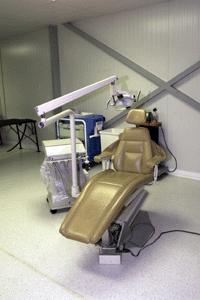 the new photos, though.
the new photos, though.
The $9.7 million dollar contract for the construction of the camps went to Brown and Root, a subsidiary of Halliburton. The contract could eventually total as much as $300 million if additional options are exercised. Vice President Dick Cheney is the former chief executive officer of Halliburton.
In addition to the new cells, Camp Delta has its own recreation and exercise area, library, outdoor shower, hospital and ward. “Comfort items” distributed to detainees including a prayer mat, cap, flip flops and two-piece suit.
And, dental care is provided at the detainee hospital.
Free dental care? It’s more then most Americans get.
But then another look at that chair and the skin starts to crawl. One suspects the U.S. isn’t terribly concerned with the beautiful smiles of its “enemy combatants.”
Indeed, this morning’s Washington Post describes secret overseas CIA interrogation facilities where detainees are
being tortured. The same torture techniques are of course denounced by the U.S. State Department in its annual survey of human rights violations in other countries. In fact its in some of those very countries where the CIA is setting up shop. Says one U.S. official, “If you don’t violate someone’s human rights some of the time, you probably aren’t doing your job.”
Says Human Rights Watch:
“Direct involvement or complicity in torture, as well as the failure to prevent torture by subordinates, may subject U.S. officials to prosecution under international law. Such acts are ‘grave breaches,’ or war crimes, under the 1949 Geneva Conventions. In addition, the Convention against Torture [which the U.S. has ratified] obligates all countries to prosecute persons within their jurisdiction who are implicated or complicit in acts of torture. Any competent court anywhere in the world is required to prosecute violations of the prohibition against torture.”
According to U.S. officials, nearly 3,000 suspected al Qaeda members and their supporters have been detained worldwide since September 11, 2001.


Drapetomanic sent me a link to a page on Eszter Hargittai’s Web site that has a couple of screen caps of Web sites before and after September 11, 2001.
The three site designs feature the Manhattan skyline whose twin towers were quickly airbrushed from the pages. What’s striking is that the changes occurred within three months of the attacks, as if the polite thing to do is to immediately pretend the towers did not exist.
...
On the flip side, the official Operation TIPS Web page has vanished. Here’s a cached version. The disappearance is probably related to Section 880 of the Homeland Security Act of 2002 which declares that
“Any and all activities of the Federal Government to implement the proposed component program of the Citizen Corps known as Operation TIPS (Terrorism Information and Prevention System) are hereby prohibited.”
Though that didn’t stop New York State from starting their own.
...
Also gone from the Web is the scary logo and much information from the site of the Defense Department’s Total Information Awareness program. See a couple of screencaps of the site before and after. From news.com:
“If fully implemented, TIA would link databases from sources such as credit card companies, medical insurers, and motor vehicle databases for police convenience in hopes of snaring terrorists.
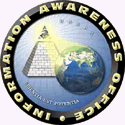 First, biographical information about the TIA project leaders, including retired Adm. John Poindexter, disappeared from the Defense Department’s site last month. A mirror that one activist created from Google’s cache shows the deleted information included four resumes listing past work experience but no addresses or contact information.
First, biographical information about the TIA project leaders, including retired Adm. John Poindexter, disappeared from the Defense Department’s site last month. A mirror that one activist created from Google’s cache shows the deleted information included four resumes listing past work experience but no addresses or contact information.
Then, sometime in the last week, the TIA site shrank still more and some links ceased to work. The logo for the TIA project—a Masonic pyramid eyeballing the globe—vanished, a highly unusual step for a government agency. So did the TIA’s Latin ‘scientia est potentia’ slogan, which means ‘knowledge is power.’...
The disappearing documents come as the TIA has become a lighting rod for criticism and as online activists have been turning the tables on Poindexter by reposting his personal information and home telephone number as widely as possible....
The TIA project became public early this year when President Bush chose Poindexter, who was embroiled in the Iran-Contra scandal, to run the Information Awareness Office. But criticism of the project from privacy advocates and newspaper editorial pages has spiked in the last month, and the Web deletions appear to have been in response to the increased public scrutiny.”
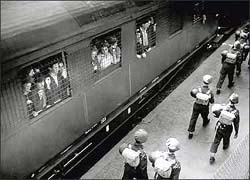 The people in the black and white photo behind the bars of the boxcar in the 1940’s German train station are not Jews off to the camps to be killed. They are indeed German Jews off to a camp, but the photo was taken after the end of war, the soldiers on the platform are British, and the passengers are survivors of Nazi concentration camps, denied entry into Palestine. Here, they are being transported from Hamburg docks to the Poppendorf detention camp.
The people in the black and white photo behind the bars of the boxcar in the 1940’s German train station are not Jews off to the camps to be killed. They are indeed German Jews off to a camp, but the photo was taken after the end of war, the soldiers on the platform are British, and the passengers are survivors of Nazi concentration camps, denied entry into Palestine. Here, they are being transported from Hamburg docks to the Poppendorf detention camp.
The photo and its story are reproduced in Underexposed. From Vision On Publishing:
“Underexposed tells the stories behind the photographs which determine our view of history, providing a reality check on alleged events from the last hundred years and documenting the struggle of the powerful to contend with rival cultural forces of media and information. Reclaimed from the trash cans of the Second World War. From the cruelty of Stalin’s Russia and fundamentalist chaos in Iran to the horrors of the Gulf war and perspectives on September 11th — even Hitler’s preening speech rehearsals come back to argue with his self-made myth. Via disgruntled starlets, ecological destruction and US nuclear tests, Underexposed gathers together some of the most ideologically dangerous photographs ever taken and releases them to haunt the increasingly manipulated, re-touched present.”
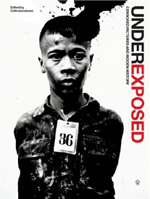 I found the book on the front table at St. Mark’s Books, mixed with the latest compilations on cyber-typography, club flyers, erotica, and graphic novels. The juxtaposition is continued on the publisher’s Web site. Among the publisher’s list of glossy photo books of rock stars, fashion, erotica, and a celebration of the Manchester City Football Club (and its fans), Underexposed seems a bit like war porn. The design of the book is certainly less than sober, full of dramatic, oversized, full-bleed spreads and a hip sans serif typeface. Each photo is provided with some background, but the captions only allow so much space.
I found the book on the front table at St. Mark’s Books, mixed with the latest compilations on cyber-typography, club flyers, erotica, and graphic novels. The juxtaposition is continued on the publisher’s Web site. Among the publisher’s list of glossy photo books of rock stars, fashion, erotica, and a celebration of the Manchester City Football Club (and its fans), Underexposed seems a bit like war porn. The design of the book is certainly less than sober, full of dramatic, oversized, full-bleed spreads and a hip sans serif typeface. Each photo is provided with some background, but the captions only allow so much space.
The bottom line: photographs can lie. Particularly those that purport to be objective. Taken out of context, they are cropped, altered, and framed by the context at hand and by cultural assumptions. And page after page, the flouting of taboo and power starts to flatten out. Like all the speakers in the corner of Hyde Park, all ideologies become equivalent.
That said, the book does rouse a healthy dose of skepticism. It also crosses into the terrain of Barthes’s Mythologies, an examination of connections between language, imagery, ideology, and power and a wandering interrogation of “the obvious.”
From a review in The Guardian:
“In one of the most shocking images, taken from the Sudanese famine of 1984, Wendy Wallace photographed the photographers at work snapping an emaciated child who had been brought out to sit in the dirt precisely for that image.
It is a theme that recurs in Alex Webb’s pictures of the American invasion of Haiti. A line of US troops lies dramatically - heroically - on the Tarmac at Port au Prince airport aiming their weapons at an unseen enemy. Most media organisations showed this image. Webb’s version shows the reality: the only figures are half a dozen and more photographers and cameramen crouched in front of the soldiers, puncturing the dramatic image in a campaign that was to see virtually no opposition to US troops.”
See an excerpt from the forward to the book, some photos from the book, or listen to an audio interview with Colin Jacobson, former photo editor for a number of British news magazines and editor of Underexposed.
...
Also of note, The Commissar Vanishes: The Falsification of Photographs in Stalin’s Russia, an small online exhibit of doctored photos and propaganda posted by the Newseum. Shown here, Stalin with Nikolai Yezhov, commissar of water transport, before and after he was purged.
page 1 2 3 4 5 6 7 8 9 10 11 12 13 14 15 16 17 18 19 20 21 22 23 24 25 26 27 28 29 30 31 32 33 34 35 36 37 38 39 40 41 42 43 44 45 46 47 48 49 50 51 52 53 54 55 56 57 58 59 60 61 62 63 64 65 66 67 68 69 70 71 72 73 74 75 76 77 78 79 80 81 82 83 84 85 86 87 88 89 90 91 92 93 94 95 96 97 98 99 100 101 102 103 104 105 106 107 108 109 110 111 112 113 114 115 116 117 118 119 120 121 122 123 124 125 126 127 128 129 130 131 132 133 134 135 136 137 138 139 140 141 142 143 144 145 146 147 148 149 150 151 152 153 154 155 156 157 158 159 160 161 162 163 164 165 166 167 168 169 170 171 172 173 174 175 176 177 178 179 180 181 182 183 184 185 186 187 188 189 190 191 192 193 194 195 196 197 198 199 200 201 202 203 204 205 206 207 208 209 210 211 212 213 214 215 216 217 218 219 220 221 222 223 224 225 226 227 228 229 230 231 232 233 234 235 236 237 238 239 240 241 242 243 244 245 246 247 248 249 250 251 252 253 254 255 256 257 258 259 260 261 262 263 264 265 266 267 268 269 270 271 272 273 274 275 276 277 278 279 280 281 282 283 284 285 286 287 288 289 290 291 292 293 294 295 296 297 298 299 300 301 302 303 304 305 306 307 308 309 310 311 312 313 314 315 316 317 318 319 320 321 322 323 324 325 326 327 328 329 330 331 332 333 334 335 336 337 338 339 340 341 342 343 344 345 346 347 348 349 350 351 352 353 354 355 356 357 358 359 360 361 362 363 364 365 366 367 368 369 370 371 372 373 374 375 376 377 378 379 380 381 382 383 384 385 386 387 388 389 390 391 392 393 394 395 396 397 398 399 400 401 402 403 404 405 406 407 408 409 410 411 412 413 414 415 416 417 418 419 420 421 422 423 424 425 426 427 428 429 430 431
[ Back ]
[ Next ]



